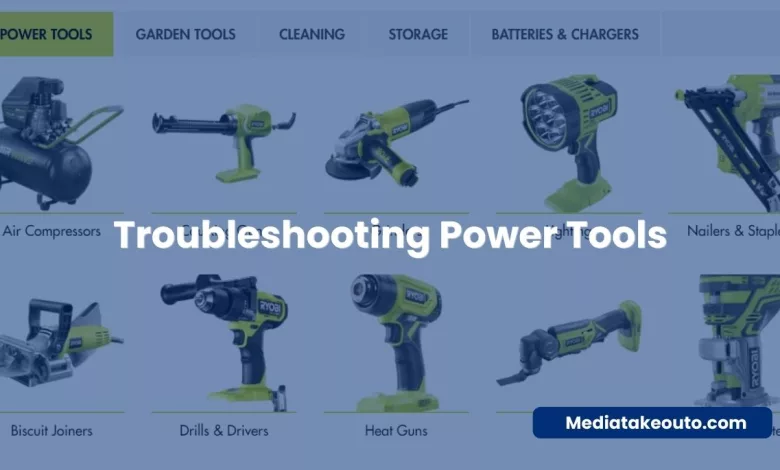Troubleshooting Power Tools: 10 Proven Methods for Success

Power tools have become indispensable in various industries and home improvement projects, offering efficiency and precision. However, like any machinery, power tools are not immune to issues and malfunctions. Understanding how to troubleshoot common problems can save time, money, and frustration.
This comprehensive guide explores ten proven methods for troubleshooting power tools, helping both professionals and DIY enthusiasts keep their equipment running smoothly.
1. Check Power Source and Cords
The most basic yet often overlooked step in troubleshooting power tools is checking the power source and cords. Ensure that the power outlet is functioning correctly by plugging in another device or tool. If the outlet is working, inspect the power cord for any visible damage, such as cuts or frayed wires.
Damaged cords can compromise the tool’s performance and pose safety risks. If issues are found, replace or repair the cord as necessary.
2. Inspect the Power Switch
A faulty power switch can lead to power tool malfunctions. If the tool doesn’t turn on or experiences intermittent operation, inspect the power switch. Check for any debris or dust that might be affecting the switch’s functionality. Toggle the switch back and forth to see if it feels loose or if there’s any unusual resistance. If the switch is damaged or feels faulty, it may need to be replaced.
3. Examine the Carbon Brushes
Carbon brushes play a crucial role in the operation of many power tools, transferring electrical current to the tool’s motor. Over time, these brushes can wear out, leading to decreased performance or complete tool failure. Consult the tool’s manual to locate the brushes and inspect them for wear. If the brushes are significantly worn down, replace them with new ones according to the manufacturer’s specifications.
4. Address Overheating Issues
Power tools, especially those with powerful motors, can overheat during extended use. If a tool suddenly stops working or exhibits signs of overheating, allow it to cool down before further use. Check for obstructions in air vents or cooling mechanisms that may impede proper airflow. Additionally, ensure that the tool is not being overloaded with tasks beyond its capacity, as this can contribute to overheating.
5. Evaluate Battery-Powered Tools
For battery-powered tools, troubleshooting involves assessing the condition of the batteries. If a cordless tool is not holding a charge or fails to power up, the batteries may need replacement.
Additionally, confirm that the batteries are appropriately charged and within their expected lifespan. Investing in high-quality replacement batteries can significantly extend the life of battery-powered tools.
6. Assess Motor Issues
The motor is the heart of any power tool, and malfunctions can lead to various problems. Unusual noises, a burning smell, or decreased power may indicate motor issues. In such cases, disassemble the tool (following safety guidelines) and visually inspect the motor for signs of damage or wear.
If the motor is beyond repair, replacement may be the best course of action. Regular maintenance, such as lubricating moving parts, can help prevent motor issues.
7. Address Vibrations and Misalignments
Excessive vibrations or misalignments during tool operation can lead to poor performance and potential damage. If a tool vibrates excessively, check for loose or damaged components. Tighten any loose screws, bolts, or parts that may be causing the issue.
Misalignments, such as a skewed blade or drill bit, can be corrected by adjusting or realigning the tool’s components according to the manufacturer’s guidelines.
8. Examine the Gear System
Many power tools, such as drills and saws, rely on a gear system for proper functioning. Grinding noises, erratic movements, or unexpected stalls may indicate issues with the gear system. Carefully disassemble the tool to access the gears, inspecting them for signs of wear or damage. Lubricate gears regularly to prevent friction-related problems. If gears are damaged, replacement may be necessary.
9. Verify Electrical Connections
In corded power tools, the integrity of electrical connections plays a crucial role in facilitating the efficient transmission of power. To ensure the safe and effective operation of these tools, it is imperative to regularly inspect the wiring for potential issues. This inspection should specifically target loose connections, exposed wires, or damaged insulation, as these issues can compromise both safety and performance.
Identifying any problems in the wiring of corded power tools is paramount to mitigating safety hazards. If any irregularities are detected during the inspection, prompt and appropriate action should be taken to address them. This not only safeguards users from potential electrical risks but also contributes to the tool’s longevity and optimal functionality.
10. Consult the Manufacturer’s Manual
Manufacturers offer comprehensive manuals for their power tools, presenting crucial information encompassing troubleshooting, maintenance, and safety protocols. When confronted with challenges related to a power tool’s functionality, it is advisable to refer to the manufacturer’s manual for precise troubleshooting steps and recommended solutions.
The manufacturer’s manual serves as a reliable resource, providing specific insights tailored to the tool’s design and specifications. By adhering to the guidelines outlined in the manual, users can ensure that their troubleshooting efforts are aligned with the intended usage and features of the power tool.
Aside from consulting the manuel, you can just search the web with keyword like “troubleshooting for RYOBI power tools”
A Comprehensive Guide to Troubleshooting Power Tools
Troubleshooting power tools is a skill that can save both time and money, allowing users to address issues promptly and extend the lifespan of their equipment. By following the ten proven methods outlined in this guide, users can confidently diagnose and resolve common power tool problems.
Regular maintenance, adherence to safety guidelines, and a proactive approach to troubleshooting contribute to a smoother and more efficient power tool experience for both professionals and DIY enthusiasts alike. Remember, safety should always be a top priority when working with power tools, and users should follow proper safety precautions outlined in the tool’s manual.






